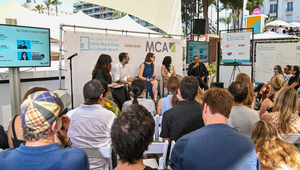
Art for Change: Meet the Judges for the UK

The 2024 theme, ‘Tomorrow’ing: Visions of a better future’, invites emerging artists to tackle some of the world’s most pressing issues and act as a beacon of hope in the pursuit of a better tomorrow.
Six winners from around the world will be decided by some of the best business and creative minds from the M&C Saatchi Group globally and eminent guest judges.
In this Art for Change series, we hear from our regional judges. Find out what makes them tick artistically, why this year’s theme is so critical, and what they are looking for in our winners
Introducing M&C Saatchi's judges for the UK: Kurt Beers, founder and director, BEERS London, Guy Bradbury, creative partner, M&C Saatchi UK, Sophie Newman, creative director, M&C Saatchi Talk.
Q> An alien lands on earth and asks you to explain your job. What would you say?
Kurt Beers> My job consists of identifying artists and artworks whose ethos speaks to relevant contemporary issues in society and art, and also reflect the aesthetic of our gallery. A lot of these works resonate deeply with ongoing dialogues in the art world, which has its own concerns, too. But in short, I look for artists who have something to say through their art and, frankly, who excite me. We have a platform to share artists to a greater public and that's something I find very exciting.
Guy Bradbury> I get paid to have fun.
Sophie Newman> I create the moments you and your alien mates talk about in the group chat.
Q> Is there a piece of work that you believe has changed the game in your industry?
Kurt> My immediate response is the Cattelan banana. I can't think of a piece in recent history that has contested the value, merit, and worth of art. Dealers, buyers, artists and even the general public were completely engaged in a fairly heated discussion about art, money, and even the merits of art and artists. It was pretty riveting to be working at that time - and we were also in Miami that week. Even a contentious discussion about art is still bringing attention to the arts. The second piece, I think, would be Banksy's Balloon Girl that was infamously shredded at auction. An important piece doesn't need to be a piece that is universally liked. An important piece brings conflicting opinions to our industry. Ambivalence is the death of art. I welcome strong opinions.
Guy> The work of Dove, led by our very own CEO, Jo Bacon, changed the beauty industry.
Sophie> With regards to PR, earned-first creativity feels like it’s having its moment and brands and agencies, not just PR ones, are realising its potential.
Just look at Cannes Lions and the Effies over the past few years. The major winners were all earned first ideas, and PR agencies are stealing the show! Change is in the air.
Q> What inspired you to join the judging panel for this year’s Art for Change Prize?
Kurt> I have a unique perspective in an ever-changing art industry and through my gallery, we've introduced a number of key new voices to the international art industry. I've had an ongoing guest curatorial spot at Saatchi Gallery and I also authored two art books, (100 Painters of Tomorrow & 100 Sculptors of Tomorrow) - the adjudication of which, frankly, was a really fun and educational process.
Guy> Art has the power to change tomorrow. Who wouldn’t want to see that.
Sophie> Who wouldn’t want to see creativity try and solve some of our most pressing issues?
Q> If you could collaborate with any artist, living or dead, who would it be?
Kurt> I often think about Agnes Martin - how these quiet and spiritualist works also housed such magnitude and resonance. What I love about Martin is also the mythos surrounding her work; this was an artist whose entire being and purpose revolved around her work. 'Practice what you preach', right? I think artists who come at their work with empathy, integrity, and honesty is the key. One thing that becomes quickly evident are artists who are more interested in being 'influential' on social media that they lose sight of the core meaning of their practice.
Guy> Bansky.
Sophie> I grew up traipsing around France every weekend with my antique dealer parents, so I’d have to go with Cezanne. He went against traditions and painted what he felt, not what he saw.
There’s a lot to be said for that approach when creating ideas. I want it to give me the feels.
Q> This year’s prize theme is ‘Tomorrow’ing: Visions of a better future’. What do you hope to see from the entries?
Kurt> I am looking for work that utilizes new technologies to bring fresh perspectives to traditional modes of creation. We are at such an exciting time with the advent of new modes of expression and artists or works that appropriate or use these advancements in exciting ways is, probably, going to excite me. The title of the show suggests works focusing on the environment, sustainability, and the long-term protection and viability of our planet. I would love to see some entries that are brilliantly executed and bring new modes of thought and production to the forefront.
Guy> Something that connects things that nobody has connected yet.
Sophie> Optimism and hope. When you turn on the TV, open the newspaper or go on social, it’s easy to feel overwhelmed with the state of play.
I’d love to see people focus on the solutions for a better tomorrow and the good that can be reached through creativity. Show us the way forward.
Q> Why do you believe it is important for society to support and invest in the arts?
Kurt> Art tells stories, records history, and has the power to influence and change opinions. Creative expression is a constant and evolving exercise that allows us to understand the world around us. Art is comprehension and allows us to see those parts of society that we must fight hard to protect and promote, or conversely, shine a light on those things we need to change. Investing in the arts as a collector and/or government bodies or agencies is fundamental to the long-term betterment of an already fractured world. When we look back in history, it is the arts and artists - the writers, painters, philosophers - that allow us to contextualize and comprehend what has happened and where we are going.
Guy> Creativity has the power to change the world, to make people stop in their tracks, engage in an idea and learn something new. Creating new connections, new memories and new ideas.
Sophie> Many of life’s challenges need creative solutions and the arts gift a set of skills to do that, which no other subject can.
Thinking creatively and innovatively, working independently and collaboratively, and learning traits such as determination and resilience. You need all those things to be able to create change.
Q> What advice would you give to someone thinking about entering this year’s prize?
Kurt> Keep your written material concise and to the point. Focus your works and maintain a consistent through-line. Jurors don't want to see a few photographs and a few sculptures. Identify how you want to be perceived and curate a tight selection that responds directly to the brief.
Guy> Make it mean something.
Sophie> It might seem like the challenges the world are facing are big things that as individuals we can’t influence. But even a small step forward is progress towards our end goal of a better tomorrow. i.e. just do it!
Q> What does ‘Art for Change’ mean to you?
Kurt> The best art is transformative - it evokes passion and asks questions about the world around us. In my opinion, art is less about answering existing questions as it is posing new ones.
Guy> Art is for everyone and can be by anyone. It can drive conversation and at the same time transcend language. Tapping into the basic human emotions within all of us.
Sophie> It means creativity for all. Every one of us should have the chance to access the creative world. We all have the ability to create value and solve problems through creativity.















